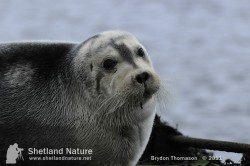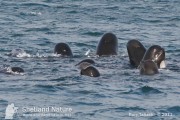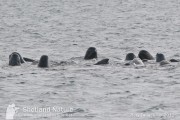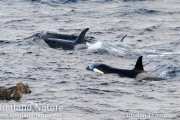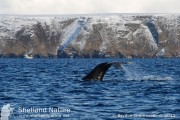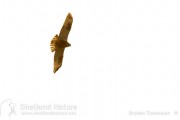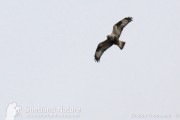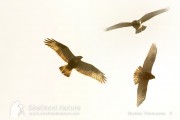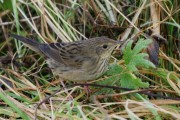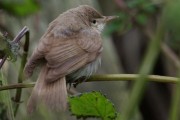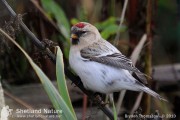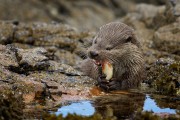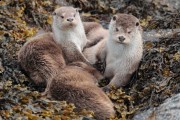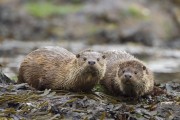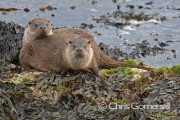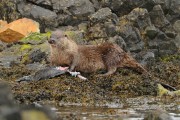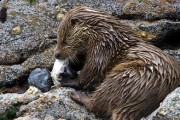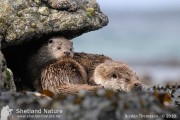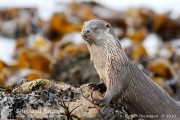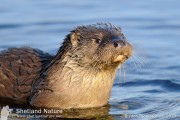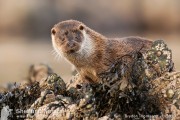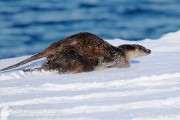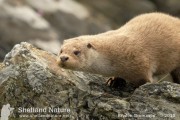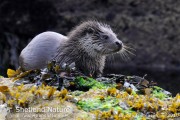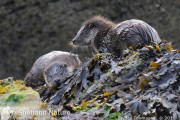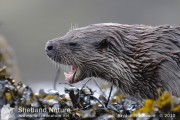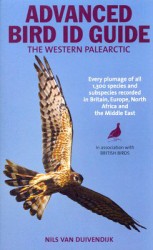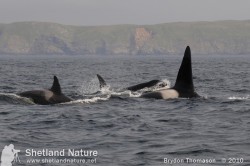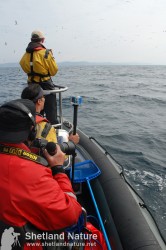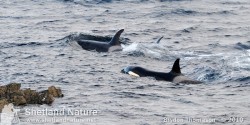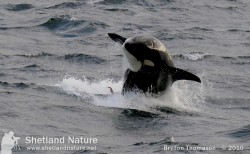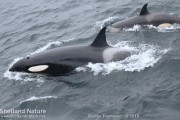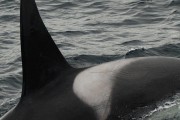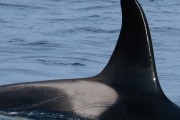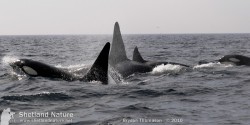Bearded Seal in Baltasound
Posted by Brydon Thomason on Wednesday 6th April 2011 | Sea Mammals in Shetland
Only a year since Shetland’s last visit from this majestic Arctic sea mammal (read our news post on last year’s Bearded Seal), this beautiful beast was discovered in Baltasound on Unst. It was only minutes after finishing our dinner that a rather excited Desley Ritch appeared at our door and proceeded to thrust her camera’s LCD screen towards my face, in a sort of ‘see what I’ve seen’ sort of way. “Is this something different?” She asked in a cheerfully sarcastic tone, “Blimey- its a Bearded Seal!” I exclaimed, as she went on to say that they, her and her brother Christopher (who had found it earlier in the afternoon) were quite sure that that’s what it was.
Desley had hardly begun explaining where it was and my jacket was on and boots were being laced up. Thankfully it was just a few minutes along the road right slap bang in the middle of a reasonably busy little marina where it lay hauled out on the slip way. Whilst my wife Vaila got ready to join me I quickly rang the news around – desperate to get down there before the light went all together, it was already after six!
Thankfully, we managed to get news around every one locally and within minutes we were all stood barely a few meters away from a Bearded Seal, all the way from the Arctic! Unfortunately the seal proved not to be as long a stayer as last year’s individual, which was only the 12th record for Shetland and only lingered for another two days. A voicemail that eventually found its way through to my mobile later that evening was from Christopher earlier in the afternoon with the news – while I was out on a boat photographing a King Eider, yip that’s Shetland for you, a naturalist’s paradise!
Permalink
Pilot Whales in Lerwick Harbour
Posted by Brydon Thomason on Monday 7th March 2011 | Sea Mammals in Shetland
How many times do you find yourself being told “Oh, you should have seen it…” or “Where were you? It was incredible!” Well this time I heard them all and more! Pilot Whales or Caain Whales (as they are known in Shetland) have become very rare in Shetland over the past couple of decades or more, so a pod of over twenty in Lerwick harbour caused quite a lot of excitement to say the least. Not only were they right in the harbour, just off Lerwick’s main pier, but it was also a Saturday so they could be enjoyed by even more lucky observers.
Amongst the assembled crowds were many friends, including a couple of our tour leaders, Rory Tallack and Helen Moncrieff and our web developer David Gifford (few of whom were subtle about how much I had missed out!). So where was I? About as far away as I could have been, on Unst with my mobile phone out of signal (one of the few downsides to living in the north isles)! The first I was aware of their presence was well after 09:00hrs when my phone buzzed to life with texts and voicemails, all of which were about the whales. The first of them, at 07:25, was from the crew of the Bressay, informing me of a pod of at least 20 whales or dolphins in the harbour (it’s calls like these that are crucial not only so sea mammals are hopefully identified and recorded but also so that as many people as possible get to enjoy such fabulous world-class encounters). Later another to say they were possibly Caain whales or maybe Risso’s dolphins. Amongst the other messages was one from Jonathan Wills (in the Czech Republic!) of Seabirds-and-Seals with news of the sighting. It is reassuring how quickly news gets around on sightings like these.
But Pilots were not the only whales to put in an appearance that day. Amongst the messages was a voicemail from a ferry crew on Yell Sound with news of a pod of Killer Whales! Perhaps slightly more expected, this sighting was of a pod of five and came only days after I had prompted crew members to keep their eyes peeled as we were just about bang on time for the first sighting of the season. It is very likely (although with no photos we can’t be sure) that this pod will be the same pod of five that has arrived during this early period in the spring for the last three years. Prior to last year, it comprised only four animals but arrived back with a fairly newly born calf last year. Slowly a pattern of sightings is starting to appear and especially with thanks to the work of Andy Foote and Volker Deeke of the North Atlantic Killer Whale ID project.
Late winter and early spring sea mammal sightings are in actual fact not as uncommon as you might think. Remarkably, we identified Humpback Whales on almost the same date in February exactly the same location (Bluemull Sound) two winters running, and then on the third (2010) they appeared in December. Perhaps these sightings are of the same individuals following the same route as they migrated north. All of these sightings were thanks to our local contacts being quick off the mark and calling us with their sightings, keep the calls coming!
Permalink
The King of Eiders
Posted by Brydon Thomason on Sunday 27th February 2011 | Birding in Shetland

A memorable day indeed and a very welcome find back in March 2006. A pristine drake in his full and exquisite breeding attire.
There can be few species of bird (let alone sea duck) as exquisite in appearance as a drake King Eider. It is hard to find a word that describes just how strikingly ornate the head and bill pattern is on a fully mature adult but I guess with the title of King enough is said. It is indeed rather apt that their Latin name, spectabillis means remarkable!
King Eiders have a largely circumpolar breeding range and are quite common throughout various regions of the high Arctic. In Britain they are regarded as a ‘national rarity’ with their having been somewhere in the region of 200 plus records of the species in the whole country. It was first added to the British list in 1832. Perhaps not surprisingly and like so many other species of Arctic vagrant to reach Britain, Shetland alone has hosted at least half of these.
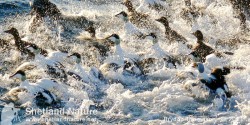
Eiders in action, the tightly bunched flock race across the water’s surface as a small boat cruises past.
Historically Kings have regularly occurred throughout the isles and typically found associating with the local Eider flocks as singles and even occasionally multiples. Their beautiful pale, frosty- blue crowns, clown like eye make-up and bulbous orangey-yellow bill shield atop of the red bill are usually easily picked out amidst even a large flock of our local Dunters (the Shetland name for Eider). Structurally they are usually obviously smaller and a little more compact too by comparison.
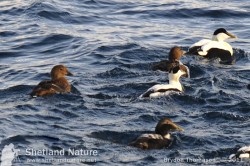
Female King Eider. A much more subtle bird indeed, this ‘Queen’ spent just a couple days amongst the Bluemull Sound winter flock in November 2008.
Immature drakes and females are however quite a different matter. To the untrained eye any of these plumages will very often blend in amongst a Dunter flock without a second glance. Females are what could be compared and referred to as ‘little brown jobs’, although that is really a descriptive term for small featureless brown warblers, pipits, buntings and so on.
They are of course every bit as adorable to me, so cute and compact in appearance with such subtle features. With experience though these subtleties can become quite striking and are the very reason they stand out, if that makes sense! A small brown, seemingly featureless duck may seem challenging to pick out amongst the very similarly plumaged local females.
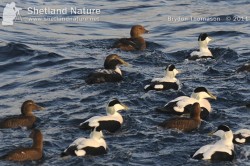
‘Queen’ Eiders have been known to spend as long as six days on the nest without leaving and will scarcely feed during the 22-24 day incubation period.
A combination of these features do however create a surprisingly distinct appearance; smaller and more compact overall size and structure, shorter and neater black bill which runs up onto a much less angular head profile, a ‘teddy bear’ like eye which shows a slight ‘tear drop’ line falling away behind and also a ‘grinning’ line which runs back a little from the closed gape. These latter two features especially combine to show a very cute but actually rather sad facial expression. The feathering also runs further down from the forehead onto the bill than on our Eiders.
In addition to these features are two others which can sometimes be just that little bit harder to see; the black flank barring forms arrow head like chevrons as opposed to the straighter and more vertical bars on a female Eiders flanks, they also have feather formations that appear on their back which are often raised creating tiny ‘sails’ which occasionally stand up like little dorsal fins but these are never as prominent as on a drake.
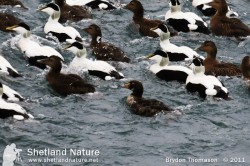
Interestingly for a sea duck, King Eiders are known to migrate overland in some populations and have been known to reach altitudes of up to 1,000m. I wonder where this young fellow was hatched?
Immature and sub-adult plumages of King Eider can be just as subtle, especially on a first winter bird. This is exactly the plumage I found one in in mid-February amongst the Eiders on Bluemull Sound, my favourite and premier winter birding site. The ‘young Elvis’ (“ah- hu hu”) was amongst a flock of around 150-200 Dunters, (less than quarter of the wintering flock there) and is actually the second of this age to be seen in Shetland this winter. Similar to the structural differences described in females, to me he was quite easy to pick out but it was his orangey yellow bill tones and compact shape that made him immediately identifiable.
Some have described this plumage of King as grotty or drab but although I can see why, I couldn’t disagree more, finding the little fellow made my day! This young King was actually the ninth King Eider I have ever found in Shetland, having previously found two females, two first winter drakes and four adult drakes (all were single birds amongst Eider flocks). And indeed a couple of these were known to be annual returnees for a couple of winters. I have also been fortunate to enjoy many others over the years in Shetland.
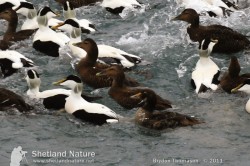
The first winter plumaged King huddles together amongst the melee of Dunters, the adult drake behind the two centre females is presumed to be of the ‘Northern’ form borealis. A novelty shot to have them both in the frame (note his tiny pert white ‘sails’ on his back and brightly coloured bill).
Searching for this and indeed other rare forms of Eider is undoubtedly one of my main winter birding motivations. One of these forms, regarded as subspecies or race, is Borealis or ‘Northern Eider’ (as they are also known) which are thought to hail from Nearctic regions. Several of these have also brought me much joy in their discoveries amongst their local cousins but as is the case with so many subspecies their identity, taxonomy and origin are still under discussion. And finally there is the one that all birders dream of finding (yes that’s right and quite often too), Steller’s Eider! Oh how I hope I can write a finders account for one of those, someday…
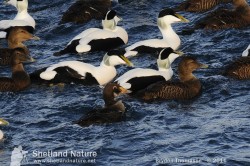
1st winter King Eider, Bluemull Sound, 3rd March 2011.
*Update* What a difference a bit of light makes! A more recent image taken on 3rd March…
Permalink
Rough-legged Buzzard(s) – a double whammy!
Posted by Brydon Thomason on Wednesday 5th January 2011 | Birding in Shetland
With 2010’s influx of Rough-legged’s in Britain in late autumn/winter my enthusiasm to find one for myself (having never found one) was peaking and given there had already been a few, I was fairly sure I could be in with a chance. I had made several trips up the very rough track to Valla Field (a distinct advantage of driving a Freelander!) and Saxavord and other similar sites on Unst since late October as I figured they were fairly likely RLB sites although Snowy Owl and Gyr are also on my radar for these sites.
Persistence at last paid off when on the 29th of December my luck was in and soaring along the very wild and rugged West facing rocky hill side of Valla Field was a stunning Rough-legged Buzzard. How perfectly placed it looked in such a beautifully remote and dramatic landscape. Two days later I took my wife Vaila and one year old son Casey along and enjoyed good but distant views, all except wee Casey of course who slept through the whole encounter!
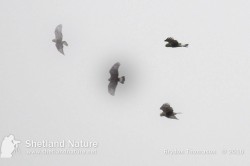
Rough-legged Buzzard, montage, December 29th 2010.
The sheer rocky ridge along the west facing hill (not at all dissimilar to the Arctic landscapes they are so at home in) which drops down to a flat and fairly green plateau called Collister which is scattered with small lochens and old ruined crofts which overlook the oceanic Atlantic horizon to the West. It is undoubtedly one of my favourite places in Shetland with its stark beauty well out of view of any main roads.
It was here that I was drawn to for my New Year’s Day walk (which is something of a personal tradition). Having walked the hills which lead to the North I had been slightly disappointed not to have seen the Rough-legged and continued down to Collister. To my surprise I met the Buzzard drifting north as I continued south along the cliff-tops.
I hurried across to the foot of the hills where I watched it gain height and begin to soar and glide in the up-drafts. But hold on a second I thought to myself as watched on in disbelief through my trusty Zeiss 10×42’s, a second bird drifted into my field of view, there was two of them!! I couldn’t and for a second didn’t believe my own eyes, two Rough-legged Buzzards together. I had ended the year by finding one only days before in 2010 and I began the year of 2011 by finding another, an RLB double whammy- happy New Year indeed!
Permalink
The Shetland Nature Autumn Adventure – 2010 Report
Posted by Martin Garner on Sunday 19th December 2010 | Birding in Shetland
This was my first birding tour, and it’s hard to see how it could be bettered – good weather brought good birds to be enjoyed in beautiful surroundings, expert leading and each hard day’s birding was finished off with a terrific meal and lots of laughs.Paul-Bright Thomas
With the terrific team effort involved in Britain’s 3rd Taiga Flycatcher (read full finder’s story) as well as self found Marsh Warbler, Yellow-browed Warbler and Barred Warbler our promotion weekend in autumn 2009 had set a rather high standard! Would we be able to maintain it the following year?
You decide. Here’s a flavour of our outstanding 2010 autumn birding adventure – from team effort finds such as Blyth’s Read Warbler, White-billed Diver and Lanceolated Warbler to quality mega’s such as Sykes’s Warbler (s!) and Buff-bellied Pipit…
» Read the full eight-day round up …
Permalink
Otter Photography in Shetland 2010
Posted by Brydon Thomason on Saturday 18th December 2010 | News
As the final few days of 2010 draw to a close and as 2011’s calendar continues to fill in (already close to capacity for my Otter photography calendar) I thought it was a nice time to reflect on the past season, of both my own and more importantly my client’s Otter images.
I am pleased to say that my continued success rate remains and I have yet to have a single a day that a photographer has gone home disappointed! This year’s very busy season of photographers seeking to capture their own images of Shetlands wild Otters included some well-known names such as David Tipling, Peter Cairns, Mark Hamblin and Chris Gomersall (follow their links to read their testimonials).
As recommended most photographers chose two-three days (often more) which is certainly the most productive option; simply maximising the potential of photographic encounters and a better chance of hitting good light or weather conditions and more time to visit a variety of my favourite sites.
Throughout the season of Otter photography there were some early starts and some late finishes; some wild weather but also some wonderful- but there were always images to take away!
Here is a selection of some of my client’s images from this season;
These are some of my own images and favourites from this season;
 And I am proud to recommend our wildlife photography clothing sponsors Stealth Gear, which I was wearing when taking all the images above.
And I am proud to recommend our wildlife photography clothing sponsors Stealth Gear, which I was wearing when taking all the images above.
Permalink
Review: Advanced Bird ID Guide by Nils van Duivendijk
Posted by Martin Garner on Thursday 16th December 2010 | Reviews
A Review by Martin Garner
Back in 1980 I wrote a couple of pocket-sized booklets filled with the bullet points of key identification features for lots of really rare birds. Just in case one day I bumped into some of them and couldn’t remember what to look for.
I had a little dream. One day I would publish these little bullet point booklets – surely others beside me would value such a tool. I never got it published. Instead Nils van Duivendijk has done something like it, only made a much better job of it. The Advanced Bird ID Guide is far more comprehensive than anything I had conceived and much nicer looking! If you haven’t seen a copy yet, you may be a little taken a- back. It’s like no other ‘field guide’ indeed, bird book of any kind, which you will have seen before. No illustrations – well apart from 2 plates of comprehensive monochrome topographical illustrations near the start. The rest is text, just text.
Originally published in Dutch in 2002, this English version is extensively updated and superbly edited by Shetland Nature tour leader Rob Fray. Covering some 1,300 species and subspecies, it’s hard to image more detail and data squeezed into such a well organised, compact space.
First feel is of a handy compact, spiral notebook-sized soft back book. An inviting colour front cover with a ‘three- fingered’ adult female harrier – Pallid or Montague’s. These are not always easy so I decided to check the harrier section to see how well it would perform in helping me confirm (or otherwise) my identification hunch. A quick check reveals an immense amount of data on Harriers. And within less than 2 minutes the photo is easily assessed – yes it’s a Montagu’s.
Each species data section has pink, left hand margin highlighting which age/ sex / plumage category is being discussed. Next to this, the bullet point list of characters. This ranges from 2-3 lines (e.g. Mediterranean Strom Petrel) to 1-2 pages (e.g. American Herring Gull).
I have worked with Nils on the very thorny subject of Steppe Buzzard identification. So I am already familiar with this incredible attention to details and sharp eyes. As I have thumbed through the content, again and again I have discovered details about species and subspecies which are well beyond my ever ability to ever commit to memory. It’s hard to see how it won’t quickly become part of my normal kit – one for my car kit bag and one for the book shelf at home. At such a reasonable price too, it’s likely to reduce the hesitation to purchase. So Yes, I am a fan.
On our recent Shetland Nature autumn birding break we even came up with a new verb – ‘to Nils a bird’. Meaning: To gain more information of a bird identification features or perhaps to correctly age it or sex a particular individual– one just needs to ‘Nils it’. A quick and easy process!
Should you get one? No book is truly ‘essential’. But with my book shelves groaning and space at a premium- here is surely the greatest mass of bird identification data in one very small easily accessible place. I can safely say now, that mine won’t be available to be loaned out for the foreseeable future – so you need to get your own! For as little as £10.00 a proper bargain too.
Martin Garner
Permalink
A round up of Killer Whale sightings in Shetland 2010
Posted by Brydon Thomason on Thursday 2nd December 2010 | Sea Mammals in Shetland
By Andy Foote, Brydon Thomason and Suzanne Beck
Even as this year draws to a close there have been killer whale sightings around Shetland. So it seems like a good time to look back at the comings and goings of our killer whales during 2010.
The first whales showed up in late March (23rd) in Yell Sound, which is consistent with the past few years. We got a chance to photograph them from the Yell Sound ferry, but the sun was working against us and the images were backlit and we couldn’t really positively ID any of the whales. One of the female-sized fin silhouettes however had two distinctive notches in the trailing edge, which looked very much like the female with ID number 12. But other individuals had silhouettes that did not match any of the fins in our photo-id catalogue, and so it seems like we had some new whales!
The new individuals appeared to stick around for a couple of weeks as the fin shapes match with those seen hunting in Scalloway harbour only days later on the 28th March and with 2 males photographed in Yell Sound on the 8th April.
May was a quiet month around Shetland, and all the action was further south. The group of four (27, 34, 72 & 73) that are regularly seen around Shetland showed up in Scapa Flow (6th May) and have a new calf! It appears as though 27 is it’s mum as it stayed closest to her in all the photos we were sent. The photo (left) of this pod was taken on Bluemull Sound on 15/03/08.
We got to follow this groups travels through a series of great photos provided by the public. On the 13th May they were seen off Durness in Sutherland, but they headed east again and were photographed on the 20th off Whaligoe steps, Ulbster, Caithness, they didn’t show up again until 23rd August when they were photographed off the Faeroes feeding on eiders and doing some hunting training with the youngsters, and even hit the headlines by making it on to the Faeroese evening news.
12 and her group were also sighted regularly in May, being photographed between Shrapinsay and Kirkwall on the 9th May, and then Duncansby Head, Caithness on 16th, they were back up to Orkney where they took a marine mammal in Eynhallow Sound on the 25th May, before heading South again, being seen back off Caithness on the 28th May, they then headed west and were last positively identified off St Kilda on 12th June. They may have also paid a fleeting visit to Shetland as a group that looked like them were photographed on 8th July off Bressay, but it was choppy weather and the photos weren’t clear enough to be sure.
Larger groups of killer whales were also getting seen feeding on herring offshore and about 25 miles east of Shetland during May. Photos we received were all of individuals not previously catalogued.
June was pretty quiet too, until on the 23rd a group of 5 showed up in Yell Sound and took either a seal or porpoise just off the ferry. This was the start of an unprecedented run of sightings from the Yell Sound ferry, with almost daily sightings for a month. Photos that we have received or collected ourselves between 23rd June and 24 July showed that most of these sightings were of the same group of 5, which were positively IDed on the 23rd June, 7th, 12th, 15th and 18th July. The group had not previously catalogued and it seems highly likely that they are newcomers to Shetland.
They weren’t the only group seen around Shetland at this time, as noted above the group on Bressay were definitely not the same group, and our old friend Bigga (ID number 14) was seen on his own off Gutcher on 10 July and again on two occasions over the following fortnight on Yell Sound.
Further South again photographs came in of the female with ID number 15 group who we last saw in 2009 off Bluemull Sound, once off the Moray Firth on the 29th June and then off Orkney on the 20th July.
So this year due to the amazing public contribution of photos, we’ve been able to track some pods as they have moved over quite a considerable distance, we’ve been able to monitor the birth of new calves, and we’ve seen what look like 2 sets of newcomers to the Northern Isles, suggesting that killer whale sightings in this area may be on the increase.
A massive thank you to everyone who contributed to this year’s efforts, the support continues to grow each summer!
Read more about the ID project at www.northatlantickillerwhales.com
Permalink


